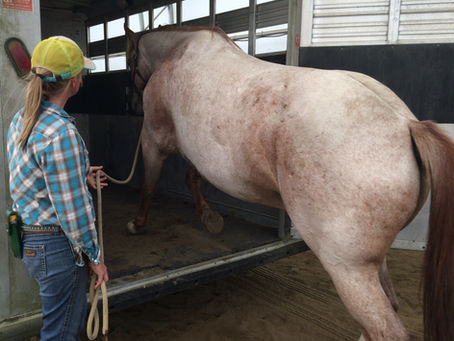top of page

HORSE BEHAVIOUR BLOG
Search


'Scared Horses are Pretty Horses'
Misunderstood images of stressed or frightened 'pretty' horses aren't a new, social media phenomenon. But they are a problem.
Lauren Fraser, MSc, FFCP
Oct 27, 20203 min read


Classical Conditioning & Horses
All animals, including humans and horses, respond to the same powerful principles of learning. One of these principles, classical...
Lauren Fraser, MSc, FFCP
Jul 2, 20202 min read


Triage Advice: Punishment & Horse Behaviour Problems
I see horses for a variety of behaviour problems, such as aggressive behaviour, general anxiety, specific fears about various things or...
Lauren Fraser, MSc, FFCP
Jun 24, 20201 min read


Your Horse's Trust Bank Account
When you train your horse, are you making deposits in the trust bank account, or are you making withdrawals? Many horses I see have trust...
Lauren Fraser, MSc, FFCP
Jun 6, 20203 min read


Triage Advice: Horse is Mouthy When Haltered
A common complaint from horse owners is that their horse is mouthy when haltered. The horse mouths or nips them, or the halter or...
Lauren Fraser, MSc, FFCP
May 28, 20202 min read


Your Horse Needs to Learn to Yield to Pressure
As I type this, I am on evacuation alert at home due to a wildfire burning, uncontained, 2 km south of my home in our remote community....
Lauren Fraser, MSc, FFCP
Apr 17, 20203 min read


#WIATW - Ponying Horse Off a Bike
I am fortunate to be able to work from home during the Covid-19 crisis. Between work, I've been spending more time training my own horses...
Lauren Fraser, MSc, FFCP
Apr 8, 20202 min read


Behavioural Injuries in Horses
Horse owners are all too aware of how a physical injury can temporarily sideline - or even permanently lame - their horse. This knowledge...
Lauren Fraser, MSc, FFCP
Mar 6, 20204 min read


Shaping Plans 101: The Best Training Tool
A shaping plan puts to paper exactly what steps you will take to teach a horse a new, wanted behaviour. Taking a few minutes to write a...
Lauren Fraser, CHBC
Jun 25, 20191 min read


Girth or Cinch Tightness: Two Places to Always Check
Most people only check in one location on the horse's body when determining the tightness of a girth or cinch - just above the horse's...
Lauren Fraser, MSc, FFCP
Jun 15, 20191 min read


Trailer Loading: Recognizing Thresholds, Building Confidence
Almost every interaction we have with a horse affects their confidence. No matter our horse training goals, this confidence - in...
Lauren Fraser, CHBC
Jun 7, 20193 min read


Teach Your Horse To Willingly Put The Bit In Their Own Mouth
Teaching your horse to willingly put the bit in their own mouth is easily done using positive reinforcement and shaping. Positive...
Lauren Fraser, CHBC
Jun 5, 20192 min read


Start Buttons and Horse Training
What's a start button, and why should it be part of your horse training? A start button is a way for an animal to give consent to...
Lauren Fraser, CHBC
May 23, 20192 min read


'You can't train a behaviour at the time that you need it.'
While technically you can sometimes train a behaviour when you need it, there may be unwanted consequences to taking this approach. What sho
Lauren Fraser, CHBC
Sep 1, 20183 min read


Horses (Likely) Don't Love Being Ridden: A Primer on How to Make it Suck Less
Do horses love being ridden? We need to talk about the elephant in the room. It might be hard to discuss, but it needs to be talked about....
Lauren Fraser, CHBC
Dec 4, 20178 min read


Expanding Your Horse's Comfort Zone - Part Two
If you haven't read Part One of Expanding Your Horse's Comfort Zone, it's here. Welcome to part two, where we talk about: ‘Just right’...
Lauren Fraser, MSc, FFCP
Apr 15, 20175 min read


Horse Training Tips #3: The Dead Horse Test
One small shift in how you think about horse training can change the way you train horses, forever. And you'll have a dead horse to thank...
Lauren Fraser, MSc, FFCP
Apr 9, 20173 min read


Horse Training Tip #2: Trail Riding Solo
Spring is made for trail riding. It's not too hot yet. The mosquitoes are still sluggish. And if you're like me, after a long winter you...
Lauren Fraser, MSc, FFCP
Apr 8, 20173 min read


Horse Training Tip # 4: Where to Begin
Good horse training involves not only identifying training goals, but also where to begin. After all, if you don't know where the horse...
Lauren Fraser, MSc, FFCP
Mar 2, 20163 min read


Horse Myth #9 - 'Don't Pet a Frightened Horse, You'll Reinforce His Fear'
“Don’t pet your horse when he’s afraid. You’ll just reinforce his fear!” A classic! This myth is also said about dogs and kids, and...
Lauren Fraser, CHBC
Oct 29, 20142 min read
bottom of page